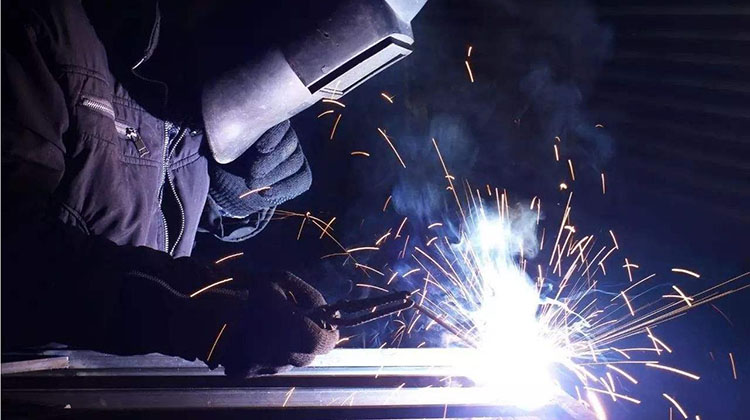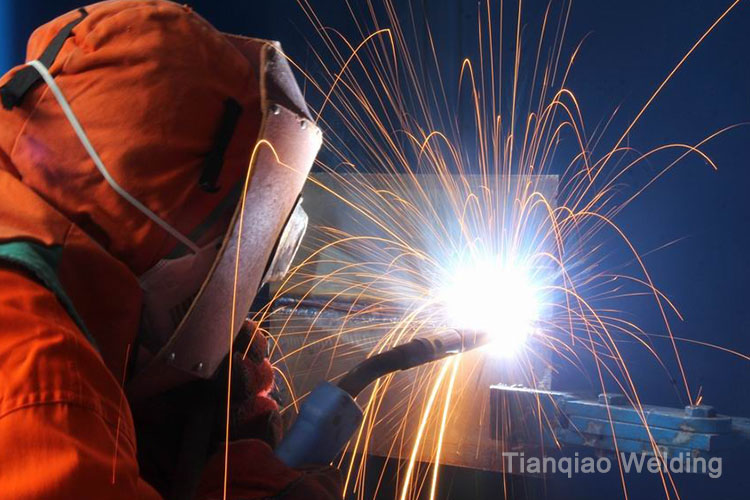Welding current, voltage and welding speed are the main energy parameters that determine weld size.
1. Welding current
When the welding current increases (other conditions remain unchanged), the penetration depth and residual height of the weld increase, and the melting width does not change much (or slightly increase). This is because:
(1) After the current increases, the arc force and heat input on the workpiece increase, the position of the heat source moves down, and the penetration depth increases. The penetration depth is nearly proportional to the welding current.
(2) After the current increases, the melting amount of the welding wire increases almost proportionally, and the residual height increases because the melting width is nearly unchanged.
(3) After the current increases, the diameter of the arc column increases, but the depth of the arc submersible into the workpiece increases, and the movement range of the arc spot is limited, so the melting width is almost unchanged.
2. Arc voltage
After the arc voltage increases, the arc power increases, the heat input of the workpiece increases, and the arc length is lengthened and the distribution radius increases, so the penetration depth decreases slightly and the melting width increases. The residual height decreases, because the melting width increases, but the melting amount of the welding wire decreases slightly.
3. Welding speed
When the welding speed increases, the energy decreases, and the penetration depth and penetration width decrease. The residual height is also reduced, because the amount of deposition of the wire metal on the weld per unit length is inversely proportional to the welding speed, and the melting width is inversely proportional to the square of the welding speed.
where U represents the welding voltage, I is the welding current, the current affects the penetration depth, the voltage affects the melting width, the current is beneficial to burn through without burning, the voltage is beneficial to the minimum spatter, the two fix one of them, adjust the other parameter can weld the size of the current has a great impact on the welding quality and welding productivity.
The welding current mainly affects the size of the penetration. The current is too small, the arc is unstable, the penetration depth is small, it is easy to cause defects such as unwelded penetration and slag inclusion, and the productivity is low; If the current is too large, the weld is prone to defects such as undercut and burn-through, and at the same time cause spatter.
Therefore, the welding current must be selected appropriately, and it can generally be selected according to the empirical formula according to the diameter of the electrode, and then appropriately adjusted according to the weld position, joint form, welding level, weldment thickness, etc.
The arc voltage is determined by the arc length, the arc is long, and the arc voltage is high; If the arc is short, the arc voltage is low. The size of the arc voltage mainly affects the melting width of the weld.
The arc should not be too long during the welding process, otherwise, the arc combustion is unstable, increasing the spatter of the metal, and it will also cause porosity in the weld due to the invasion of air. Therefore, when welding, strive to use short arcs, and generally require that the arc length does not exceed the diameter of the electrode.
The size of the welding speed is directly related to the productivity of welding. In order to obtain the maximum welding speed, a larger electrode diameter and welding current should be used under the premise of ensuring quality, and the welding speed should be appropriately adjusted according to the specific situation to ensure that the height and width of the weld are consistent as much as possible.
1. Short circuit transition welding
The short-circuit transition in CO2 arc welding is the most widely used, mainly used for thin plate and full-position welding, and the specification parameters are arc voltage welding current, welding speed, welding circuit inductance, gas flow and welding wire extension length.
(1) Arc voltage and welding current, for a certain welding wire diameter and welding current (that is, wire feeding speed), must match the appropriate arc voltage in order to obtain a stable short circuit transition process, at this time the spatter is the least.
(2) Welding circuit inductance, the main function of inductance:
a. Adjust the growth rate of short-circuit current di/dt, di/dt is too small to cause large particles to splash until a large section of the welding wire bursts and the arc is extinguished, and di/dt is too large to produce a large number of small particles of metal spatter.
b. Adjust the arc burning time and control the penetration of the base metal.
c .Welding speed. Too fast welding speed will cause blowing edges on both sides of the weld, and if the welding speed is too slow, defects such as burn-through and coarse weld structure will easily occur.
d .The gas flow depends on factors such as joint type plate thickness, welding specifications and operating conditions. Generally, the gas flow rate is 5-15 L/min when welding fine wire, and 20-25 L/min when welding thick wire.
e. Wire extension. The suitable wire extension length should be 10-20 times the diameter of the welding wire. During the welding process, try to keep it in the range of 10-20mm, the extension length increases, the welding current decreases, the penetration of the base metal decreases, and vice versa, the current increases and the penetration increases. The greater the resistivity of the welding wire, the more obvious this effect is.
f. Power supply polarity. CO2 arc welding generally adopts DC reverse polarity, small spatter, arc stable base metal penetration is large, good molding, and the hydrogen content of the weld metal is low.
2. Fine-particle transition.
(1) In CO2 gas, for a certain diameter of welding wire, when the current increases to a certain value and is accompanied by a higher arc pressure, the molten metal of the welding wire will fly freely into the molten pool with small particles, and this transition form is a fine particle transition.
During the transition of fine particles, the arc penetration is strong, and the base metal has a large penetration depth, which is suitable for medium and thick plate welding structure. The reverse DC method is also used for fine-grain transition welding.
(2) As the current increases, the arc voltage must be increased, otherwise the arc has a washing effect on the molten pool metal, and the weld forming deteriorates, and the appropriate increase in arc voltage can avoid this phenomenon. However, if the arc voltage is too high, the splash will increase significantly, and under the same current, the arc voltage decreases as the diameter of the welding wire increases.
There is a substantial difference between the CO2 fine particle transition and the jet transition in TIG welding. The jet transition in TIG welding is axial, while the fine particle transition in CO2 is non-axial and there is still some metal spatter. In addition, the jet transition boundary current in argon arc welding has obvious variable characteristics. (especially welded stainless steel and ferrous metals), while fine-grained transitions do not.
3. Measures to reduce metal splashing
(1) Correct selection of process parameters, welding arc voltage: For each diameter of welding wire in the arc, there are certain laws between the spatter rate and the welding current. In the small current region, the short-circuit
transition splash is small, and the splash rate into the large current region (fine particle transition region) is also small.
(2) Welding torch angle: the welding torch has the least amount of spatter when it is vertical, and the larger the inclination angle, the greater the spatter. It is best to tilt the welding gun forward or backward no more than 20 degrees.
(3) Welding wire extension length: The length of welding wire extension has a great impact on the spatter, the length of the welding wire extension is increased from 20 to 30mm, and the amount of spatter increases by about 5%, so the extension length should be shortened as much as possible.
4. Different types of shielding gases have different welding methods.
(1) The welding method using CO2 gas as shielding gas is CO2 arc welding. A preheater should be installed in the air supply. Because liquid CO2 absorbs a large amount of heat energy during continuous gasification, the volume expansion of the gas after depressurization by the pressure reducer will also reduce the gas temperature, in order to prevent the moisture in the CO2 gas from freezing in the cylinder outlet and pressure reducing valve and block the gas path, so the CO2 gas is heated by the preheater between the cylinder outlet and the pressure reduction.
(2) The welding method of CO2 + Ar gas as shielding gas MAG welding method is called physical gas protection. This welding method is suitable for stainless steel welding.
(3) Ar as a MIG welding method for gas shielded welding, this welding method is suitable for aluminum and aluminum alloy welding.
Post time: May-23-2023


